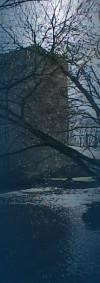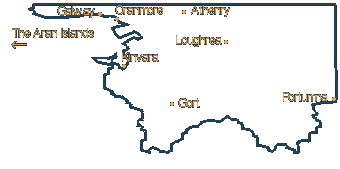


|


Athenry
A medieval town at the heart of a rich farming community that was founded by
Melier de Bermingham who built his castle by the ford on the Clareen River in
1235. A curtain wall with towers and a moat was constructed for protection.
Today this is one of the best examples of town walling in Ireland with 5 towers
and the North wall intact. A medieval festival is held here each year.
The ruins of a Dominican Priory, (built in 1241 and suppressed in 1652 by Cromwellian forces),
contains the tomb of Lady Mathilda Birmingham and other interesting grave slabs.
In the town square you will find a 15th century 'Lantern' type market cross, the
only one of its kind in Ireland.
Clarinbridge
The village, on Galway Bay is right  at the heart of Galway oyster country and
is internationally famous for Paddy Burke's Oyster Tavern and the Oyster
Festival held here in September. at the heart of Galway oyster country and
is internationally famous for Paddy Burke's Oyster Tavern and the Oyster
Festival held here in September.
The local church holds a very ancient stone tablet portraying the Virgin
Mary crowned with stars, standing on a crescent moon.
Ardrahan
A charming village with a wide market  square and cross, celebrated in history
for the victory won by Irish clans over the Normans in 1225. The rousing song
'The West's Awake' tells the tale. The area was a stronghold of the O'Heynes,
(the Lords of Aidhne), until 1236 when Richard de Burgo gave Ardrahan to
Maurice Fitzgerald. (The ruins of his castle are to the north of the village.) square and cross, celebrated in history
for the victory won by Irish clans over the Normans in 1225. The rousing song
'The West's Awake' tells the tale. The area was a stronghold of the O'Heynes,
(the Lords of Aidhne), until 1236 when Richard de Burgo gave Ardrahan to
Maurice Fitzgerald. (The ruins of his castle are to the north of the village.)
Loughrea
(Baile Locha Riach - The town of the Grey Lake)
A vibrant market town situated  on the shores of one of the best trout angling
lakes in the region. There is a park and swimming area besides the remains of
crannógs, (artificial islands on which ancient settlements once existed). on the shores of one of the best trout angling
lakes in the region. There is a park and swimming area besides the remains of
crannógs, (artificial islands on which ancient settlements once existed).
A Norman settlement was found around a de Burgo manor established after his
conquest of the country in 1235. Loughrea evolved into a well-defended medieval
town. Today only the town tower and an artificial watercourse, (the only town
moat still functioning), are all that remain of the medieval defences.
The ruins of the Carmelite Monastery founded by the de Burgos about 1300 can be
seen besides their present church.
St. Brenan's Cathedral, described as the treasure house of the Celtic Revival,
with its stained glass windows, metalwork, woodcarving, sculpture and textiles,
the work of a myriad of Irish artists. Edward Martyn, playwright and poet was
responsible for having many of these treasures installed. St. Brendan's life is
portrayed here. There is a perfect statue of the Virgin and Child and the diocesan
museum is also worth a visit.
The Turoe Stone, shrouded in all the mystery of our Celtic past, stands in the
grounds of Turoe House at Bullaun. The 1 metre high granite stone is of the La
Téne style, (originating in Switzerland), and has been dated around 200 B.C.
Aughrim
Aughrim Interpretive Centre in the village tells the story of the Battle of
Aughrim and its significance in Ireland and Europe. The Centre is open from
Easter to October, seven days a week.
July 12th, 1691 saw 20,000 men in the Williamite (King William of Orange)
army fight an equal number of Catholic Irish and French Jacobites, under the
French general, St. Ruth, in what was to be the last great land battle in Ireland.
After the bloodiest battle ever fought on Irish soil, (8,000 casualties),
the Williamites emerged victorious thus curtailing the ambitions of King
Louis XIV of France in Europe.
  
|
|

















|

